Users Manual
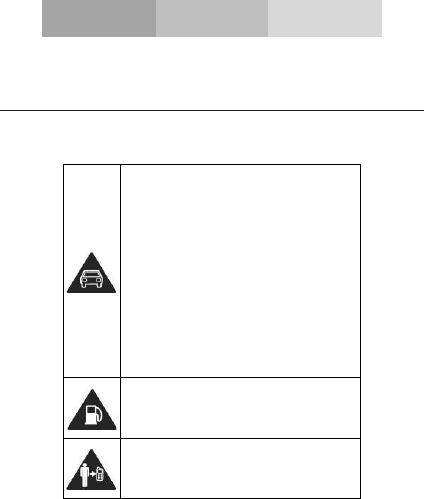
1
SECURITY INFORMATION
Please remember to obey relevant rules and regulations
whenever use your phone. This will prevent bad effect from
you and the environment.
General security
When driving, riding your bike or
walking, do not use headphones or
earphones. Your attention could be
diverted, which may cause an accident
and be against the law in certain
geographical areas. For safety
precautions do not use your phone while
driving, always stay aware of your
surroundings. Follow all safety
instructions and regulations relating to
the use of your device when you are
driving a vehicle.
Don’t use at petrol stations.
Keep your phone at least 15 mm away
from your ear or body while making
calls.
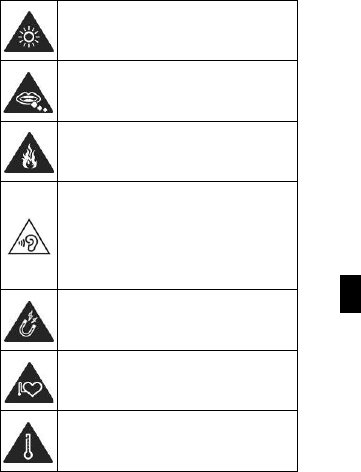
2
EN
Your phone may produce a bright or
flashing light.
Small parts may cause a choking.
Don’t dispose of your phone in fire.
To avoid any hearing damage, do not
listen to high volume levels for an
extended. Excessive sound pressure
from earphones and headphones can
cause hearing loss.
Avoid contact with anything magnetic.
Keep away from pacemakers and other
electronic medical devices.
Avoid extreme temperatures.
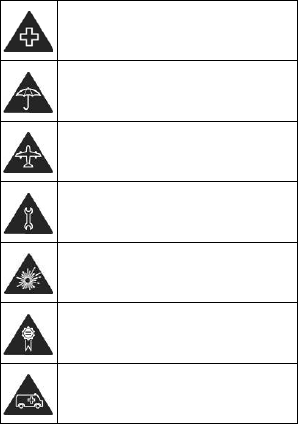
3
Switch off when asked to in hospitals
and medical facilities.
Avoid contact with liquids. Keep your
phone dry.
Switch off when told to in aircrafts and
airports.
Don’t take your phone apart.
Switch off when near explosive
materials or liquids.
Only use approved accessories.
Don’t rely on your phone for emergency
communications.
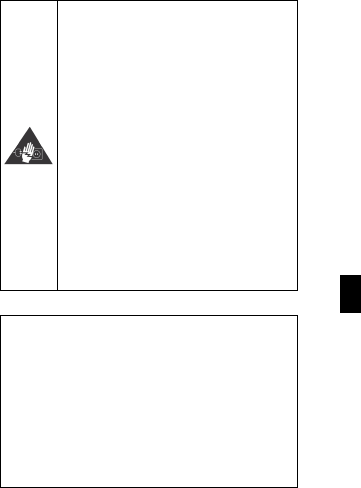
4
EN
Warning electrical hazard
To avoid serious injury, do not touch the
plug of the charger!
Disconnect the charger when you do not
use it.
To disconnect a charger or an
accessory, pull the plug, not the power
cable.
The power module is the element that
allows you to disconnect the product.
The power plug must stay easily
accessible.
Look at the adapter regularly, specifically at the
plug and the layer to detect any damages. If the
adapter is damaged, you can’t use it until it’s fixed.
Plug in the adapter to a power outlet which is
easily accessible. Always unplug the adapter after
using it.
Use only the adapter provided with the device.

5
Do not expose your device to direct sunlight, like
on your car’s dashboard, for example.
In case of overheating do not use the device.
Be careful when using the device while walking.
Do not subject the device to severe impact or drop
it from high position, it could cause damages or
malfunctions.
Do not disassemble, modify or fix the device by
yourself.
To clean the device use a clean and soft rag.
Do not use any chemical product or detergent.

6
EN
INTRODUCING YOUR MOBILE PHONE
Learn about your mobile phone’s layout, keys, display and
icons.
Unpacking
Check the product box for the following items:
• Mobile phone
• Battery
• Travel adapter (charger)
• USB Cable
• Headset
• User manual
• Quick start guide
The supplied accessories perform best for your phone.
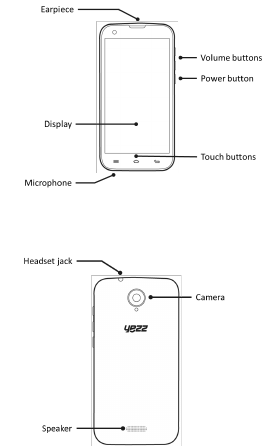
7
Phone layout
From the front view of your phone you will observe the
following elements:
From the back view of your phone you will observe the
following elements:

8
EN
Keys
The following table offers you a quick description about the
phone’s keys:
Key Function
Power
button
Allow you to turn on/off the device and
to lock the screen.
Volume
Allow you to adjust the volume of
ringing and notifications. Also allows
you to adjust the volume of multimedia
content playback.
Back
Allow you to return to the previous
menu or screen. Also allow you to close
some applications.
Home
It takes you directly to the home screen,
leaving any application open.
Menu
Allow you to access to the functions
menu of the application or screen you
are.
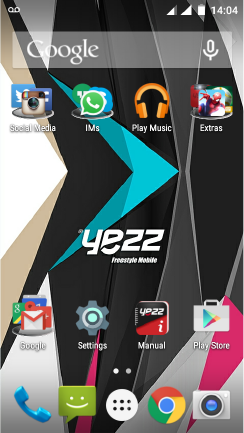
9
Screen
The screen of your mobile phone is designed as follows:
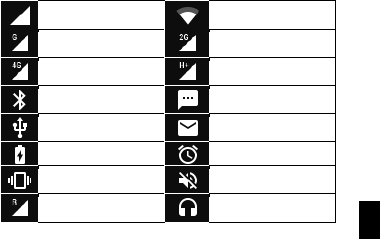
10
EN
Icons
Learn about the icons that are displayed on the top of the
screen, indicating the status of the phone:
Signal strength Wi-Fi connection
GPRS connected EDGE connected
4G connected HSPA connected
Bluetooth On New message
USB connected New email
Battery meter Alarm active
Vibration profile Silent profile
Roaming indicator Headset connected
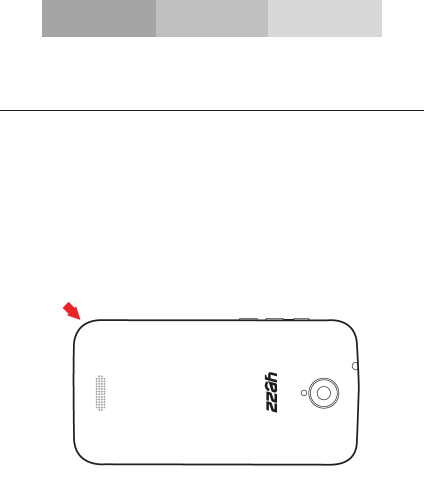
11
PREPARING YOUR MOBILE PHONE
Get started setting up your mobile phone for its first use.
Install the SIM card and battery
When you subscribe to a cellular service, you will receive a
Subscriber Identity Module (SIM) card, with subscription
details, such as your personal identification number (PIN) and
optional services.
To install the SIM card and battery,
1. Remove the battery cover.
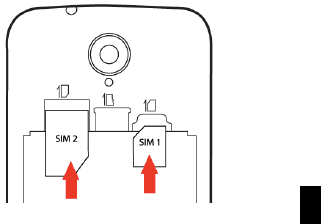
12
EN
2. Insert the SIM card.
Your phone has 2 SIM card slots to allow you use 2 SIM
cards and switch between them.
• Place the SIM card in the phone with the gold-colored
contacts facing down.
• Without inserting a SIM card, you can use your phone’s
non-network services and some menus.
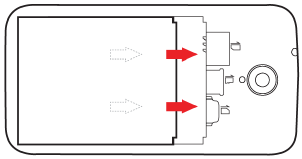
13
3. Insert the battery.
4. Replace the battery cover.
Insert a memory card (optional)
To store additional multimedia files, you must insert a
memory card.
• Formatting the memory card on a PC may cause
incompatibility with your phone. Format the memory
card only on the phone.
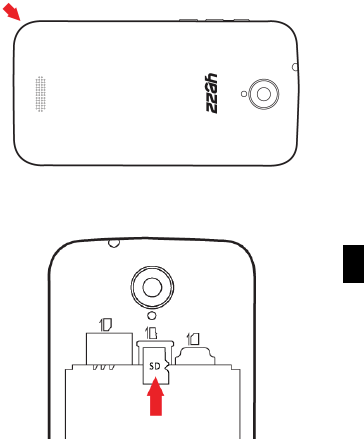
14
EN
1. Remove the battery cover.
2. Insert a memory holder with the label side facing up.

15
USING BASIC FUNCTIONS
Learn how to perform basic operations of your mobile phone.
Turn your phone on and off
To turn your phone on,
1. Long press the power button.
2. Type in your PIN number and press OK (if it is needed).
To shut down your phone, go to step 1 above.
Access menus and applications
To get access to the Menu and Applications,
1. At the home screen, touch the button on the screen to
pop up the list of Installed Applications in your phone.
2. Slide your finger to the right or left to access other pages
of apps.
3. Touch any icon to enter to the application.
4. To exit the application, press Back or Home at the bottom
of the screen.
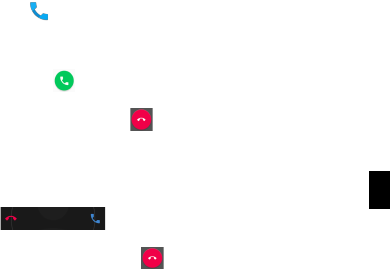
16
EN
Use basic call functions
Learn to make or answer calls in this section.
Make a call:
1. At the home screen or applications menu, touch the Phone
icon .
2. Dial the area code and phone number.
3. Touch to start the call.
4. To end a call, touch .
To answer a call:
1. When you receive a call, slide the phone icon to the right
to answer it or slide it to the left to reject it
.
2. To end the call, touch .
Send and view messages
In this section, learn how to send and receive:
- Text Messages (SMS).
- Multimedia Message (MMS).
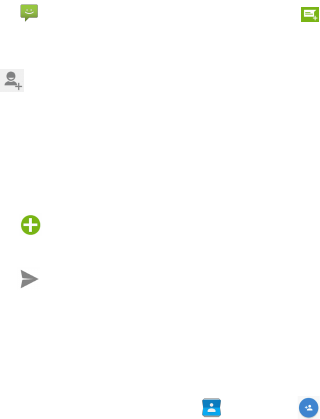
17
Steps to send Text and Multimedia Messages:
1. Touch Messages at the application list, then touch
on the corner.
2. Type in the phone number or contact name on the field or
touch to access to Contacts.
3. Type in your message.
To send as text message go to step 5.
To attach a multimedia object (audio, image, etc.) continue to
step 4.
4. Touch on the top right corner, select the attach type
then choose the item.
5. Touch to send the message.
Add contacts
Learn the basics of using the phonebook feature.
Add a new contact:
1. In the application list touch Contacts , then touch
on the bottom to add a new contact.
2. Fill the contact information (Name, Last name and phone
number). You can add more fields such as, email, address.
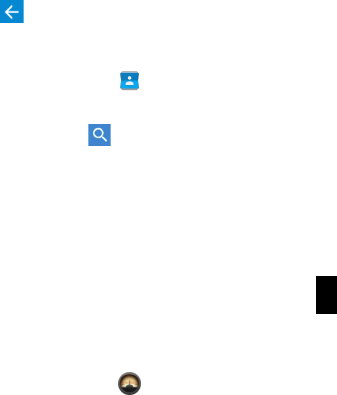
18
EN
3. Touch on the top of the screen to save.
Search for a contact
1. In the application list touch Contacts.
2. Slide your finger from bottom to top to scroll the list or
touch the search button and type in the first letters of the
name or last name.
3. To see the contact details touch the name or the picture of
the contact.
If you want to call a contact touch the phone number.
Listen to music
Learn how to listen to music via the music player or FM radio.
Listen to the FM radio:
1. Plug in the earphones in your phone.
2. In the application list touch FM Radio.
3. Use the tool bar at the bottom to change of station.
Listen to music files:
First, copy the music files into your phone internal memory or
a MicroSD card.

19
1. In the application list, touch Music.
2. Select an order at the top of the screen and touch the song
that you want to listen to.
3. You can Pause, Loop, or change of song using the tool bar
at the bottom.
Browse the web
Learn how to access to your favorites Web Sites.
1. In the application list, touch Browser.
2. Touch the address bar and type in the address of the web
site you want to go.
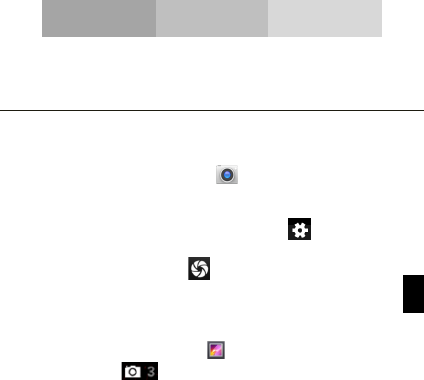
20
EN
USING THE CAMERA
Learn the basics to capture and view photos.
Capture pictures
1. In the applications list, touch Camera.
2. Adjusts the lens at the photo target and make the desired
adjustments by touching the settings button .
3. Touch the shot button on the screen to capture the
picture. It will be saved automatically.
See the captured pictures
In the applications list, touch Gallery and then select the
Camera folder to access and visualize all the pictures
captured by your phone.

21
CONNECTING TO INTERNET
Learn the basics to configure your phone and connect to
Internet.
Add a new connection
1. In the applications list, touch Settings to access to the
device configuration.
2. Touch the option “More…”, then touch Mobile networks
and touch Access Point Names. Now select the SIM Card
that you want to configure.
3. Touch the Menu key and select New APN then, type in the
parameters according with your Carrier.
The basic parameters are:
• Name
• APN
• Username
• Password
Some carriers use Proxy Servers, refer to your carrier
configuration for more information.
4. When you finish typing in the parameters needed, touch
Menu then Save.
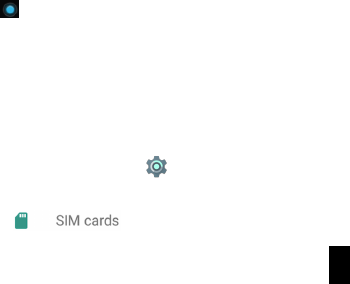
22
EN
If you have multiples APN Configurations for the same SIM
card, choose which one you want to use touching the radio
button at the right side of the name.
To add another connection, repeat from step 3.
Switch between carriers
(SIM cards)
If you use multiple SIM cards and want to switch to another
one, follow these steps:
1. In the applications list, touch Settings to access to the
device configuration.
2. Touch .
3. Choose the option Data connection and select the SIM
Card that you want to use.
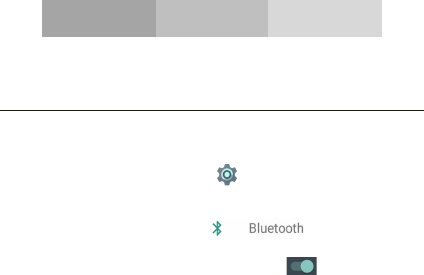
23
USING THE BLUETOOTH
Learn about your phone’s ability to connect to other wireless
devices for exchanging data.
Turn on the Bluetooth wireless feature
1. In the applications list, touch Settings to access to the
device configuration.
2. Touch the Bluetooth option .
3. To turn the Bluetooth touching the button on the right
top corner.
Find and pair with other Bluetooth enabled devices
1. When you turn the Bluetooth on, the list will show all the
available devices near you.
2. Touch the device that you want to pair with your phone.
3. Enter a PIN for the Bluetooth wireless feature or the other
device’s Bluetooth PIN, if it has one, and press OK.
When the owner of the other device enters the same code or
accepts the connection, the pairing will be complete.
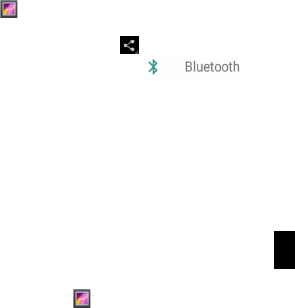
24
EN
Send images using the Bluetooth wireless feature
1. Open Gallery .
2. Choose a picture and press Share on the top right
corner of the screen and select Bluetooth .
3. Touch the device that you want to send the picture then
accept the file in the receiver.
Receive images using the Bluetooth wireless feature
1. Turn on the Bluetooth at System Settings.
2. Type in the Bluetooth PIN or accept it (if it is needed).
3. Accept the receiving file if you want to receive data from
the other device.
When the transferring is finished you can see the picture
using the Gallery Application .
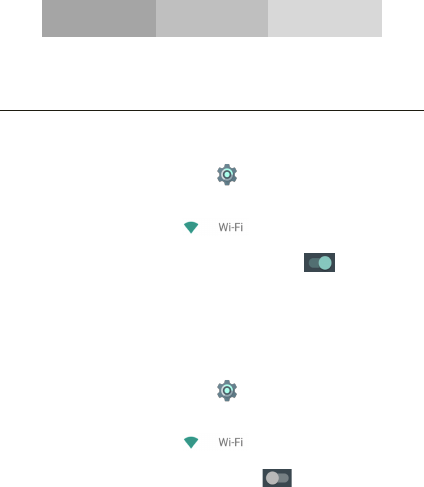
25
USING THE Wi-Fi
Learn to use the phone's wireless capabilities to connect to
any wireless local area network compatible.
Connect to a wireless network
1. In the applications list, touch Settings to access to the
device configuration.
2. Touch the Wi-Fi option .
3. To turn the On the Wi-Fi touching the button on the
right top corner.
4. Choose a wireless network and enter the security
password if it is needed.
Disconnect from a wireless network
1. In the applications list, touch Settings to access to the
device configuration.
2. Touch the Wi-Fi option .
3. To turn the Wi-Fi off touch the button on the right top
corner.
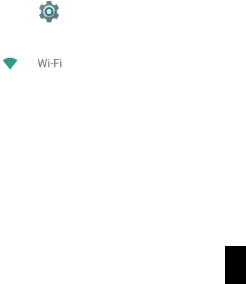
26
EN
View the technical details of a wireless network
1. In the applications list, touch Settings to access to the
device configuration.
2. Touch the Wi-Fi option .
3. Touch the active wireless network to see details such as
Link Speed, Signal strength and more.

27
EU WEEE
Information to consumers in application of EU WEEE.
This product is subject to European Union regulations that
promote the re-use and recycling of used electrical and
electronic equipment. This product required the extraction
and use of natural resources and may contain hazardous
substances. The symbol above, on the product or its
packaging, indicates that this product must not be disposed
of with your other household waste. Instead, it is your
responsibility to dispose of your waste equipment by handling
it over to a designated collection point for the recycling of
waste electrical and electronic equipment.
The separate collection and recycling of your waste
equipment at the time of disposal will help to conserve
natural resources and ensure that it is recycled in a manner
that protects human health and the environment.
For more information about where you can drop of your
waste equipment for recycling, please contact your local city
office, your household waste disposal service, or the store
from which you purchased the product.

28
EN
Recommendations:
• Do not disassemble, open or tear up the device or the
batteries.
• Do not expose the product or the battery to heat or fire.
Avoid storage the device directly to the sunlight.
• Do not short-circuit a battery. Do not stock batteries in a
drawer where it could short-circuit between each other or
get in contact by any other metallic objects.
• Do not cause mechanical shocks to batteries.
• In case of the leak, do not let the liquid get in contact with
your eyes or skin. If that happens wash with clear water
the affected zone and seek medical advice.
• Follow the marks plus (+) and minus (-) on the battery and
the device and ensure that the use is correct.
• Do not use any accessories or batteries that are not made
to be used with the device.
• Monitor the use of batteries by children.
• Consult a doctor immediately in case of ingestion of an
element or a battery.
• Always buy the battery recommended by the manufacturer
of the device.
• Always maintain the product and the battery clean and
dry.
29
• Wipe the terminals of the product or the battery, if it
became dirty, with a clean and dry rag.
• It is necessary to charge the battery before its use. Always
use the charger and read the manufacturer instructions or
the manual of the device for the instructions regarding
charging.
• Do not leave a battery charged when it’s not going to be
used.
• After long periods of storage, it may be necessary to
charge and discharge the battery several times in order to
achieve maximum performance.
• Always keep the original documentation of the device, you
might need it later for future reference.
• If it’s possible, take out the battery of the device when it’s
not used.
• Do not store your device in extremely hot or cold places
like inside of a car during the summer. It might damage
the device and cause explosion of the battery. It’s
recommended to use the device in a range of
temperatures between 5°C and 35°C.

30
EN
SAR
Please take time to read this important section.
RADIO WAVES
Proof of compliance whit international standards (ICNIRP) or
with European Directive 1999/5/EC (R&TTE) is required of all
mobile phone models before they can be put on the market.
The protection of the health and safety for the user any other
person is an essential requirement of these standards or this
directive.
THIS DEVICE MEETS INTERNATIONAL GUIDELINES FOR
EXPOSURE TO RADIO WAVES
Your mobile device is a radio transmitter and receiver. It is
designed not to exceed the limits for exposure to radio waves
(radio frequency electromagnetic fields) recommended by
international guidelines. The guidelines were developed by
an independent scientific organization (ICNIRP) and include
a substantial safety margin designed to assure the safety of
all persons, regardless of age and health.
The radio wave exposure guidelines use a unit of
measurement known as the Specific Absorption Rate, or
SAR. The SAR limit for mobile devices is1.6 W/kg.
Tests for SAR are conducted using standard operating
positions with the device transmitting at its highest certified
31
power level in all tested frequency bands.
Body-worn SAR testing has been carried out at a separation
distance of 1.0 cm. to meet RF exposure guidelines during
body-worn operation, the device should be positioned at least
this distance away from the body. If you are not using an
approved accessory ensure that whatever product is used is
free of any metal and that it positions the phone the indicated
distance away from the body.
For more information you can go to www.sayyezz.com
Additional information about electromagnetic fields and public
health are available on the following site.
http://www.who.int/peh-emf.
Your telephone is equipped whit a built-in antenna. For
optimal operation, you should avoid touching it or degrading
it.
As mobile devices offer a range of functions, they can be
used in positions other that against your ear. In such
circumstances the device will be compliant whit the
guidelines when used with headset or USB data cable. If you
are using another accessory ensure that whatever product is
used is free of any metal and that it positions the phone at
least 1.0 cm away from the body.
LICENSES
The Bluetooth word mark and logos are owned by Bluetooth
SIG, Inc. and any use of such marks by DDMBrands LLC and
its affiliates is under license. Other trademarks and trade
names are those of their respective owners.

32
EN
CE
Please take time to read this important section.
RADIO WAVES
Proof of compliance whit international standards (ICNIRP) or
with European Directive 1999/5/EC (R&TTE) is required of all
mobile phone models before they can be put on the market.
The protection of the health and safety for the user any other
person is an essential requirement of these standards or this
directive.
THIS DEVICE MEETS INTERNATIONAL GUIDELINES FOR
EXPOSURE TO RADIO WAVES
Your mobile device is a radio transmitter and receiver. It is
designed not to exceed the limits for exposure to radio waves
(radio frequency electromagnetic fields) recommended by
international guidelines. The guidelines were developed by
an independent scientific organization (ICNIRP) and include
a substantial safety margin designed to assure the safety of
all persons, regardless of age and health.
EU Regulatory Conformance
Hereby, this device is in compliance with the essential
requirements and other relevant provisions of Directive
1999/5/EC.
33
For the declaration of conformity, visit the Web site
www.sayyezz.com/certifications.
Notice: Observe the national local regulations in the location
where the device is to be used. This device may be restricted
for use in some or all member states of the European Union
(EU)
Notes:
- Due to the used enclosure material, the mobile phone shall
only be connected to a USB Interface of version 2.0 or
higher. The connection to so called power USB is prohibited.
- The adapter shall be installed near the equipment and shall
be easily accessible.
- Do not use the mobile phone in the environment at too high
or too low temperature, never expose the mobile phone
under strong sunshine or too wet environment. The suitable
temperature for the phone and accessories is -10℃-55℃.
- When charging, please place the phone in an environment
that has a normal room temperature and good ventilation. It
is recommended to charge the phone in an environment with
a temperature that ranges from 5℃~25℃. Please ensure to
use only the charger offered by the manufacturer. Using
unauthorized charger may cause danger and violate the
authorization of the phone and the guarantee article.
- CAUTION: RISK OF EXPLOSION IF BATTERY IS
REPLACED WITH AN INCORRECT TYPE. DISPOSE USED
BATTERIES ACCORDING TO THE INSTRUCTIONS
- Excessive sound pressure from earphones and

34
EN
headphones can cause hearing loss.
For more information you can go to www.sayyezz.com
Additional information about electromagnetic fields and public
health are available on the following site.
http://www.who.int/peh-emf.
Your telephone is equipped whit a built-in antenna. For
optimal operation, you should avoid touching it or degrading
it.
As mobile devices offer a range of functions, they can be
used in positions other that against your ear. In such
circumstances the device will be compliant whit the
guidelines when used with headset or USB data cable. If you
are using another accessory ensure that whatever product is
used is free of any metal and that it positions the phone at
least 1.5 cm away from the body.
LICENSES
Bluetooth SIG, Inc. owns the Bluetooth word mark and logos
and any use of such marks by DDM Brands LLC and its
affiliates is under license. Other trademarks and trade names
are those of their respective owners.

35
FCC
Please take time to read this important section.
FCC Caution
Any Changes or modifications not expressly approved by the
party responsible for compliance could void the user's
authority to operate the equipment.
Before a new model phone is available for sale to the public,
it must be tested and certified to the FCC that it does not
exceed the exposure limit established by the FCC, Tests for
each phone are performed in positions and locations (e.g. at
the ear and worn on the body) as required by the FCC.
This device complies with part 15 of the FCC Rules.
Operation is subject to the following two conditions: (1) This
device may not cause harmful interference, and (2) this
device must accept any interference received, including
interference that may cause undesired operation.
Note: This equipment has been tested and found to comply
with the limits for a Class B digital device, pursuant to part 15
of the FCC Rules. These limits are designed to provide
reasonable protection against harmful interference in a
residential installation.
This equipment generates, uses and can radiate radio
frequency energy and, if not installed and used in accordance

36
EN
with the instructions, may cause harmful interference to radio
communications. However, there is no guarantee that
interference will not occur in a particular installation. If this
equipment does cause harmful interference to radio or
television reception, which can be determined by turning the
equipment off and on, the user is encouraged to try to correct
the interference by one or more of the following measures:
- Reorient or relocate the receiving antenna.
- Increase the separation between the equipment and
receiver.
- Connect the equipment into an outlet on a circuit different
from that to which the receiver is connected.
- Consult the dealer or an experienced radio/TV technician
for help.
Specific Absorption Rate (SAR) information
SAR tests are conducted using standard operating positions accepted by the FCC with the
phone transmitting at its highest certified power level in all tested frequency bands, although
the SAR is determined at the highest certified power level, the actual SAR level of the phone
while operating can be well below the maximum value, in general, the closer you are to a
wireless base station antenna, the lower the power output.
Before a new model phone is a available for sale to the public, it must be tested and certified to
the FCC that it does not exceed the exposure limit established by the FCC, Tests for each
phone are performed in positions and locations (e.g. at the ear and worn on the body)as
required by the FCC.
For body worn operation, this model phone has been tested and meets the FCC RF exposure
guidelines when used with an accessory designated for this product or when used with an accessory that
Contains no metal and that positions the handset a minimum of 1.0 cm from the body.
Non-compliance with the above restrictions may result in violation of RF exposure guidelines.